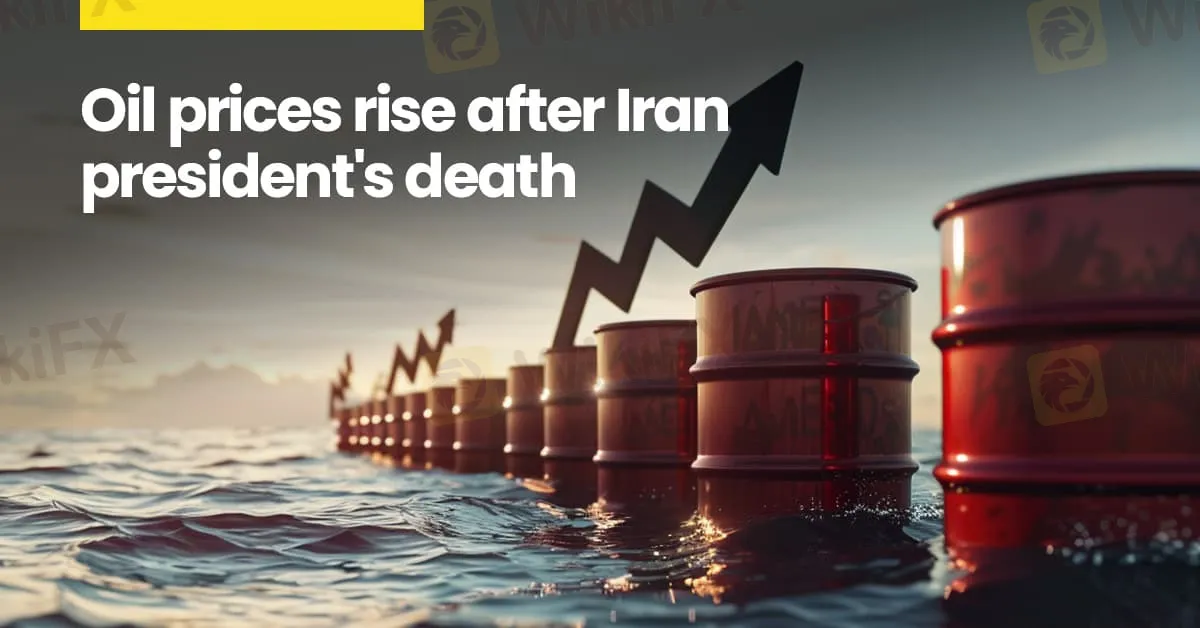简体中文
繁體中文
English
Pусский
日本語
ภาษาไทย
Tiếng Việt
Bahasa Indonesia
Español
हिन्दी
Filippiiniläinen
Français
Deutsch
Português
Türkçe
한국어
العربية
Oil Prices rise after Iran president’s death
Abstract:According to the report, oil prices surged during early Asian trading on Monday, building upon last week's upward momentum. This uptick was driven by multiple factors, including the unfolding search for Iran's president after a helicopter crash in the oil-rich nation and the United States' decision to purchase crude to bolster its national reserves.

According to the report, oil prices surged during early Asian trading on Monday, building upon last week's upward momentum. This uptick was driven by multiple factors, including the unfolding search for Iran's president after a helicopter crash in the oil-rich nation and the United States' decision to purchase crude to bolster its national reserves.
As of 0049 GMT, Brent crude had risen by 26 cents, representing a 0.3 percent increase, reaching $84.24 per barrel. Similarly, U.S. West Texas Intermediate (WTI) crude saw a gain of 15 cents, or 0.2 percent, reaching $80.21 per barrel.
The previous week concluded with Brent crude experiencing a 1 percent uptick, marking its first weekly gain in three weeks. Meanwhile, WTI crude climbed by 2 percent, buoyed by positive economic indicators from both the U.S. and China, the world's largest consumers of oil.
The recent surge in crude oil prices has been underpinned by several factors. Firstly, a helicopter carrying Iranian President Ebrahim Raisi crashed on Sunday, raising concerns about the safety of high-profile figures in the region. Despite this development, the impact on oil prices remained relatively subdued. Additionally, market focus is shifting towards the upcoming meeting of the Organization of the Petroleum Exporting Countries (OPEC) and its allies on June 1, where discussions on output policy are expected to provide clarity to the market.
Warren Patterson, head of commodities strategy at ING, highlighted the current state of the oil market, stating, “The oil market remains largely rangebound, and without any fresh catalyst, we will likely have to wait for clarity around OPEC output policy to break out of this range. The market also appears increasingly numb to developments on the geopolitical front, likely due to the large amount of spare capacity OPEC is sitting on,” as quoted by Reuters.
Meanwhile, seizing the opportunity presented by the recent dip in oil prices, the U.S. government announced its purchase of 3.3 million barrels of oil at $79.38 per barrel to replenish its Strategic Petroleum Reserve, following a significant drawdown from the reserve in 2022.
Last week, market sentiment received a boost from indications of easing inflation in the U.S., which raised expectations of potential interest rate cuts. Such cuts could potentially weaken the dollar, thereby making oil more affordable for holders of other currencies.

Disclaimer:
The views in this article only represent the author's personal views, and do not constitute investment advice on this platform. This platform does not guarantee the accuracy, completeness and timeliness of the information in the article, and will not be liable for any loss caused by the use of or reliance on the information in the article.
Read more

CySEC Warns Against Unauthorized Investment Firms in Cyprus
CySEC warns investors about unregulated investment firms in Cyprus. Verify broker reliability through the WikiFX app to stay protected from scams.

STARTRADER Issues Alerts on Fake Sites and Unauthorized Apps
STARTRADER warns against counterfeit sites and apps using its brand name. Protect yourself by recognizing official channels to avoid fraudulent schemes.

Dukascopy Bank Expands Trading Account Base Currencies
Dukascopy Bank now offers AED and SAR as base currencies for trading, expanding options for clients to fund accounts in Dirham and Riyal.

PayPal Expands PYUSD Transfers to Ethereum and Solana
PayPal's PYUSD stablecoin can now transfer across Ethereum and Solana, enhancing flexibility for users through a LayerZero cross-chain integration.
WikiFX Broker
Latest News
JUST Finance and UBX Launch Multi-Currency Stablecoin Exchange
XM Revamps Website with Sleek Design and App Focus
Global Shift in Cryptocurrency Taxation: Italy and Denmark Chart New Paths
Webull Introduces 24/5 Overnight Trading to Extend U.S. Market Access
TradingView & Mexico’s Uni. Partnership, to Enhance Financial Education
Something You Need to Know About SogoTrade
eToro Launches Global-Edge Smart Portfolio: A Balanced Approach to Growth and Stability
Darwinex advises traders to update MT4 & 5
Revolut X Expands Crypto Exchange Across Europe, Targeting Pro Traders
Broker Review: Is Exnova Legit?
Currency Calculator


